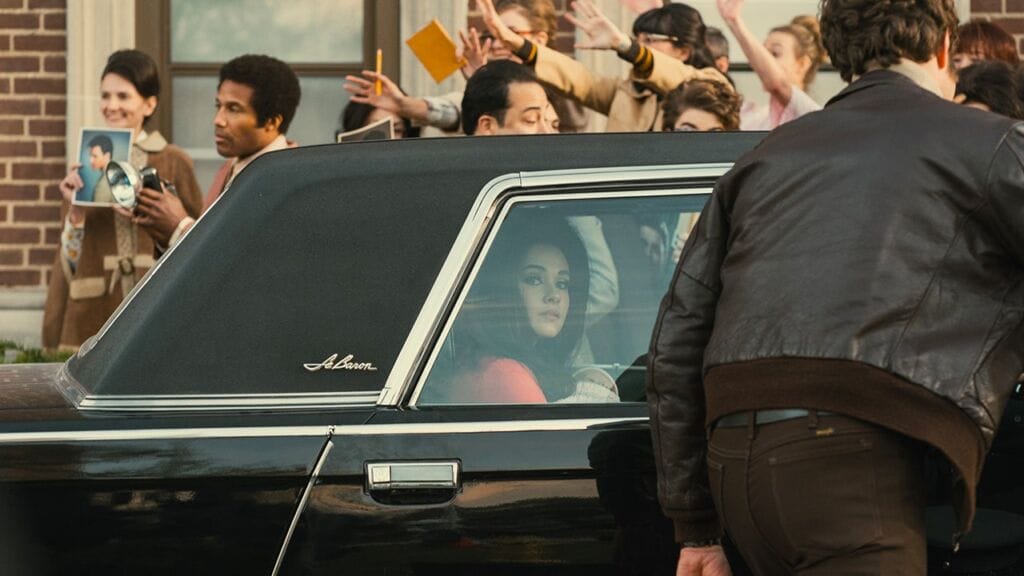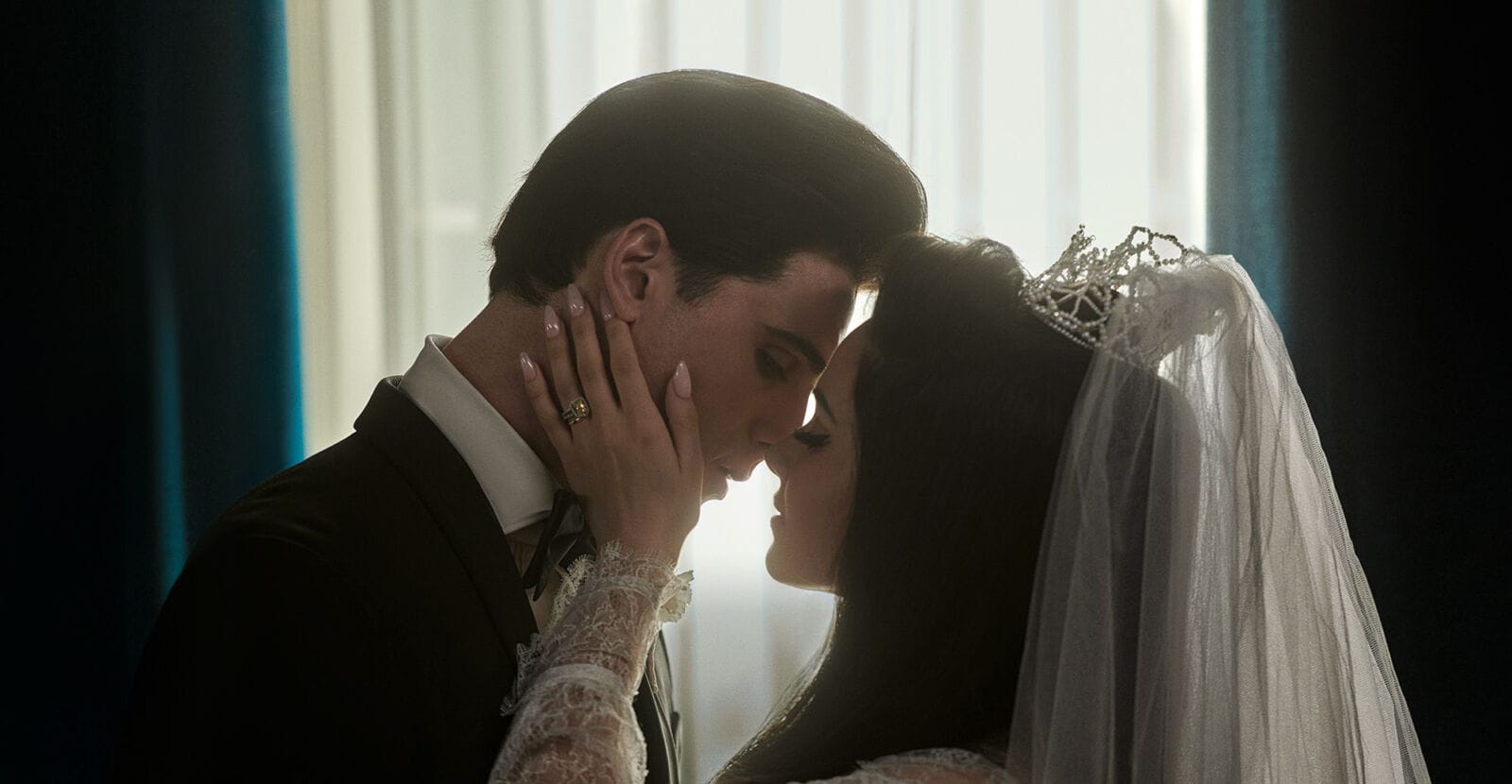Priscilla Presley is precisely the kind of person you’d expect to write a memoir—marry one of music’s most public public figures and your life is narrativized, sensationalized, co-opted by the world until you tell your story yourself, preferably with “True Story” somewhere in the subtitle (in this case The True Story of the Love Between Priscilla Presley and the King of Rock N’ Roll). Covering their relationship from introduction to divorce, it’s the tale of a young girl trapped: by fame, by love, and by a confluence of social mores insisting she stay put, trading in her agency for a stay in a gilded cage. It’s precisely the kind of story Sofia Coppola would adapt.
READ ALSO: Read all of Ryan Bordow’s movie reviews here
Coppola’s Marie Antoinette is the most obvious reference point. Swap Versailles for Graceland and the king for The King (and subtract millions of starving French people) and you have the bones of Priscilla’s story—a girl held captive by the prescribed obligations of her wealthy male benefactor. The parallels between the films’ preludes are especially illuminating: each presents a flash of what’s to come (in Antoinette, a dolled-up queen surrounded by pink as a servant attends to her feet; in Priscilla, her pedicured feet gliding across a pink Graceland carpet) before jumping back to the girls’ childhoods, which were not to last much longer. Marie was just 14 when she was married to the French dauphin; Priscilla was the same age when she was approached at a diner by a stranger with a question: “Do you like Elvis Presley?”
Of course, she says, and she’s whisked off to a party to meet The King himself, 24 years old and looking for a girl. Coppola’s handling of this sequence—visually direct and unadorned by subjectivity, narratively isolated at the beginning of the film—makes us objective observers of a dynamic in a vacuum, and it’s not hard to call it like we see it: Priscilla is being groomed. A mega-celeb sent out a scout to pick up a teenager; there’s no ignoring the truth of the thing. But there is deservedly complicating the thing, and Coppola does a tremendous job of that.
As Priscilla falls in with Elvis, her mindset bleeds into the film’s aesthetic canvas, binding the relationship’s objective grossness to the just-as-real feelings of a girl in love. The day after Elvis kisses her, she floats through school in a confident haze, the camera trained on her daydreaming face as Tommy James and the Shondells’ “Crimson and Clover” suffuses the air with sweetness (another instance of period-inaccurate music in a Sofia Coppola biopic—whatever best connects us to feelings decades old). This synthesis of sweet and dark fits Coppola like a glove: her soft, dim lighting lends a dreamlike haze to the romance, but it also allows for pools of darkness in the frame, little black holes where the natural light can’t reach—shadows in which Coppola positions Elvis’ face. It doesn’t take sensationalizing the marriage’s fallout—the drugs, the affairs, the abuse—to show us the darkness underneath the elegance.

And elegant it was, as the design work is keen to remind. The film features gorgeous replications of 60s/70s Americana, from album covers to architecture to magazine tearouts festooned in colorful shapes, capturing that modern American optimism that would die with figures like Elvis. Coppola, ever-attentive, frames much of the detail in close-up, including that of Priscilla’s style: we watch up close as she applies her signature eyeliner, making someone of herself to please that someone else. It’s lovely, it’s dark, it’s complicated; as a marriage dissolves into abuse, this woman grows up into beauty, and Coppola is careful to let the two coexist.
But the film’s personal detail is lacking. We understand Priscilla in an outside-in sort of way as the aesthetics reflect her mood, but this approach just barely scratches the surface, and the film’s script and structure exacerbate the issue. Its events take place over 14 years, and Coppola doesn’t focus in on one period, so the story plays out as a series of loose vignettes, each cut a potentially large time jump. This doesn’t let the drama build—and Coppola’s trademark restraint doesn’t help. It’s fine that she shoots Elvis hurling a chair at his wife without descending the scene into theatrics—the lack of sensationalism is one of the film’s strong points—but when an already restrained scene fades into something months later, its power dissipates in the jump. The slow-building dread of personal collapse eludes the film at key turns, and it becomes hard to feel what Priscilla might’ve felt.
Her dialogue does her less favors. She has surprisingly little, for one, even for a shy character, and what she does have is facile and obvious. In one scene, she tries on dresses for Elvis and crew when Elvis vocally disapproves of one, to which Priscilla squeaks out something to the effect of “but I like this kind” before Elvis blows up on her and she acquiesces. Scene over; it existed solely to demonstrate that Elvis controlled Priscilla’s preferences, so there’s no need to hear more from Priscilla today. If we did hear more from her (or if she were written with more palpable personality), we might’ve felt why she liked that specific dress, but her personhood floats out of reach.
Cailee Spaeny fills out the role with a sensitive performance, but it’s not enough to make up for what’s missing. There’s an emptiness to Priscilla that needs real character—every time Elvis’ manager The Colonel was mentioned, my mind was free to wander to Baz Luhrmann’s Elvis, wherein Tom Hanks played The Colonel like a cartoon villain. It wasn’t respectful or complex or even necessarily accurate, but the character felt like a full person, something Priscilla can feel short on. Rarely does a film so delicate and restrained leave me wanting for so much bluster.
★★★ (3/5)




